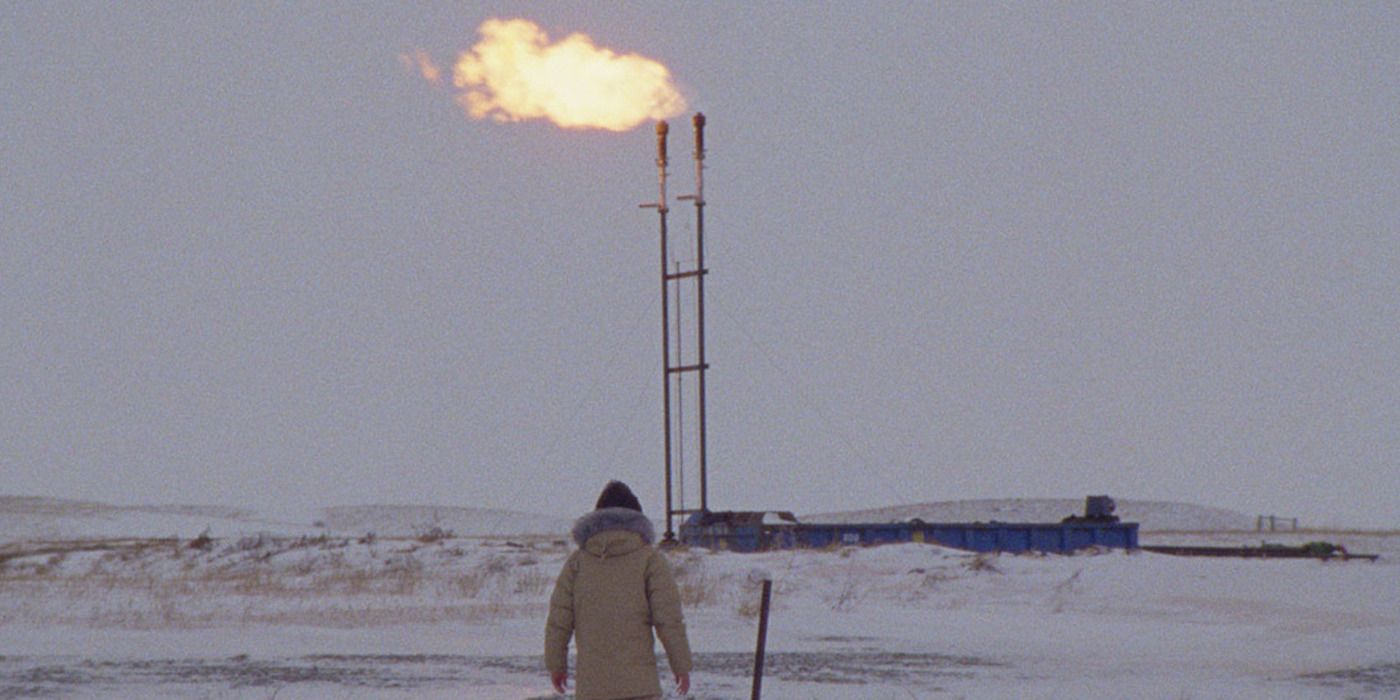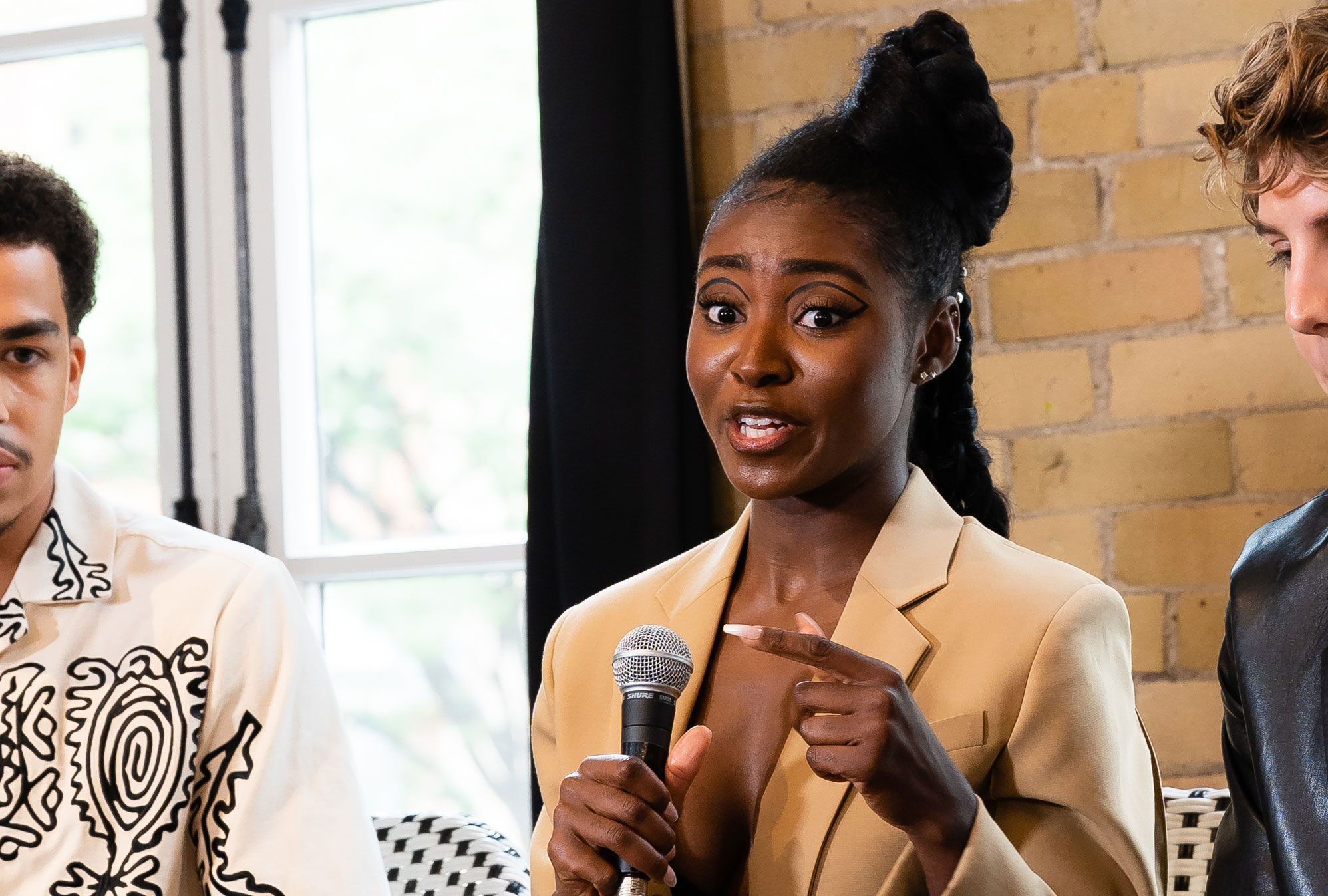If you’re looking for an excellent movie to watch right this very second, might I recommend the 2018 horror movie, Cam? It features a phenomenal performance from Madeline Brewer as Alice, a cam girl on the rise who’s itching to become top-ranked. One morning she wakes up to discover someone else using her account — an exact replica of herself.
After the release of Cam I was mighty eager to claim director Daniel Goldhaber for the horror genre, but at the Toronto International Film Festival this year he threw a curveball. I’d love to see more horror from Goldhaber one day, but it’s even more exciting to see him deliver a wildly different sophomore film that shows off a wide-ranging skillset suggesting he’s capable of tapping into any genre, presenting complex narratives, and tackling productions of any scale and scope. Goldhaber’s second film, How to Blow Up a Pipeline, couldn’t be more different from Cam, and it’s just as impressive.
Inspired by Andreas Malm’s book of the same name, Goldhaber’s film follows a group of young climate-change activists who decide that if the law won’t punish those guilty of contributing to the climate crisis, they will, so they set off to blow up a West Texas oil pipeline.
With How to Blow Up a Pipeline celebrating its world premiere at TIFF 2022, where it found the perfect home over at Neon, Goldhaber and cast members Ariela Barer, Lukas Gage, Forrest Goodluck, Jayme Lawson, Marcus Scribner, and Olive Jane Lorraine all swung by the Collider Supper Suite and Media Studio at Marbl to discuss their experience telling this story.
Goldhaber began with a brief description of the rather unique process of adapting Malm’s work:
“The movie is based on a manifesto by climate activist Andreas Malm, who basically writes about the fact that every single social justice movement in history has, at the very least, been predicated on the destruction of property, and that climate change poses an existential threat to human life on Earth and is kind of questioning whether or not property destruction is necessary to move away from fossil fuels and preserve human civilization and society as we know it, and so we adapted these ideas. The book has no story. It's just kind of political theory. We adapted these ideas into essentially a heist thriller film about young climate activists who blow up an oil pipeline in rural Texas. The movie kind of walks you through, in pretty exacting detail, how they build the bombs and how they do it and in kind of classic heist fashion, they have a very complex and exciting plan.”
This will probably come as no surprise given the article introduction, but I also had to ask Goldhaber why he decided to veer away from horror after the success of Cam. Here’s what he said:
“After Cam most of the industry opportunity that was available to me was in horror, but I think that me and all the people that I work with, you know, Isa Mazzei who produced this movie and wrote and produced Cam, Jordan Sjol who wrote and produced this movie and was a writer on Cam, we all kind of are idea-first filmmakers. And for me, I love all genre equally and I think for me it's about, how do I take a really great idea and make a film out of it that's exciting, that can really connect with a wide audience, but that also really has something meaningful to say? And so for me, this is honestly like a completely natural extension from Cam in a lot of ways and it's a lot of the same people, and I've also been lucky enough to add a bunch of new people to the collaborative team and collaborative efforts.”
Goldhaber isn’t kidding about beefing up his collaborative team because How to Blow Up a Pipeline features an especially large roster of main characters. One of the film's greatest feats? It manages to offer up a significant amount of history and purpose for every single one of them, bolstering the shared importance of this risk they’re taking together.
In an effort to tease all of How to Blow Up a Pipeline’s main players, I asked the cast for their characters' greatest strengths and greatest weaknesses when trying to complete this mission. Scribner began:
“I think for Sean one of his greatest strengths was his people skills. He was able to come to so many different people from different backgrounds and recruit them under the same like-minded goal. And his biggest weakness definitely is his fear. I think he came from a background where he wasn't directly impacted by these refineries so while committed to the plan and definitely wanting to take a stance and make a change, he also was afraid for his future. Obviously, he wants to continue going to college and having a great normal life, so I think his fear kind of ruined a lot of the things in the film.”
Lawson jumped in next to highlight her own character, Alicia, and also Alicia's connection to Sasha Lane's Theo:
“I’d say for Alicia her greatest asset was her skepticism. It kept everybody in check, just about what is actually possible and keeping us grounded on why we're doing what we're doing. And then her greatest weakness has to be Theo. Sasha Lane couldn’t be here, but I think her whole reason for being there totally and solely depends on Theo.”
Gage plays Logan, one of the bigger wild cards of the bunch. He noted, “I think Logan's biggest strength is his fearlessness, and it's also his weakness because he's an impulsive, sometimes thoughtless guy.” That impulsiveness and Logan’s relationship with another member of the group, Rowan played by Kristine Froseth, is bound to keep you especially on edge as they get further and further into the mission.
In addition to serving as an executive producer on the film, Goodluck steps in Michael, the group’s bomb-making specialist. When the strength/weakness question came his way, he absolutely nailed his answer; “I would say Michael's greatest strength is probably that he could do this by himself … but I feel like that’s his greatest weakness as well because it just would have blown up in his face, probably.”
Barer wears multiple hats on the production as well. Not only is she a producer on How to Blow Up a Pipeline, but she also co-wrote the screenplay with Goldhaber and Sjol, and she stars as Xochitl, the individual responsible for getting this operation off the ground:
“I think Xochitl’s biggest strength is probably her passion and her intelligence to put a plan like this together, and her greatest weakness is her all-consuming ego that someone simply has to have to put themselves at the center of a plan like this.”
Lorraine finished off the character descriptions by offering up one for Dwayne who’s played by Jake Weary in the film:
“I play Dwayne's wife, so I'll just speak a little bit to Dwayne. Basically I think his greatest strength is his courage and his determination. Logically, the way that he knows the land is obviously a big strength, but I think he has the Texas grit that when someone hurts themself, he's like, ‘All right, strap in! Let's handle this.’ And I'd say his weakness is not a personal weakness, but probably the fact that his family lives in poverty, and the risk that he's taking doing this has pretty extreme repercussions.”
In addition to playing Jake’s wife Katie in the movie, Lorraine also made a significant contribution to the production as a script consultant. She explained:
“I was the Texan script consultant because I was born and raised there, particularly in an oil rig town called Baytown. So I had a similar upbringing to Sasha Lane's character where I was exposed to acid rain and a lot of pollution. My entire family lineage is manual labor workers at these oil rig companies that are wildly underpaid, and so Danny and Ariela came to me and were like, ‘Hey, we have a Texan storyline in this and we know that you have personal stories attached not just to Texas, but to the oil industry.’ It was great to be along [for] the ride [on] this script and shape Dwayne in a way that felt really authentic and not just a caricature of a Texan.”
Looking for more on How to Build a Pipeline? You can check out our full conversation in the video at the top of this article!
Special thanks to our TIFF 2022 partners A-list Communications, Belvedere Vodka, Marbl Toronto, COVERGIRL Canada, Tres Amici Wines, Toronto Star, and Blue Moon Belgian White beer.





